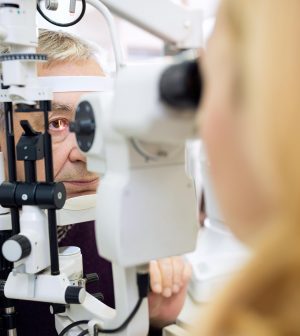- Navigating Your Midlife Crisis: Embracing New Possibilities
- City Raccoons Showing Signs of Domestication
- Mapping the Exposome: Science Broadens Focus to Environmental Disease Triggers
- One Week Less on Social Media Linked to Better Mental Health
- Your Brain Changes in Stages as You Age, Study Finds
- Some Suicide Victims Show No Typical Warning Signs, Study Finds
- ByHeart Formula Faces Lawsuits After Babies Sickened With Botulism
- Switch to Vegan Diet Could Cut Your Greenhouse Gas Emissions in Half
- Regular Bedtime Does Wonders for Blood Pressure
- Dining Alone Could Mean Worse Nutrition for Seniors
Hotter Climate Could Mean Worsening Eyesight for Americans

Older American adults who live in warmer regions are more likely to have serious vision impairment than those who live in cooler places, new research finds.
Living with average temperatures of 60 degrees Fahrenheit or above — think South Florida, for example — created much higher odds of blindness or trouble seeing even with glasses, according to a new study of 1.7 million people.
“This link between vision impairment and average county temperature is very worrying if future research determines that the association is causal,” said co-author Esme Fuller-Thomson, director of the University of Toronto’s Institute of Life Course and Aging.
“With climate change, we are expecting a rise in global temperatures. It will be important to monitor if the prevalence of vision impairment among older adults increases in the future,” she added in a school news release.
Compared with those who lived in counties with average temperatures of less than 50 degrees F, the odds of severe vision impairment were 14% higher for those who lived in counties with average temperatures from 50-54.99 degrees, according to the study.
The risk was 24% higher for those in places where temps averaged 55-59.99 degrees. For those basking in even warmer territory, the odds of vision loss were 44% higher.
Even with differences in age, sex and income, the relationship held.
“It was powerful to see that the link between vision impairment and temperature was consistent across so many demographic factors including income,” said co-author Elysia Fuller-Thomson, a graduate student at the University of Toronto.
Researchers did find a stronger association in those ages 65 to 79 compared to those who were 80 and up, and for men compared to women. It was also stronger for white people compared to Black people.
They said it’s unknown why temperature has this impact.
Potential causes are the increased ultraviolet light exposure, air pollution, infections and folic acid degradation with increased temperature, the researchers noted.
It’s concerning because vision problems are a major cause of disabilities and functional limitations, contributing to falls and poorer quality of life, the authors noted.
Data for the study came from six consecutive waves of the American Community Survey of Americans ages 65 and up.
The question on vision impairment was, “Is this person blind or does he/she have serious difficulty seeing even when wearing glasses?”
The researchers used average temperature data from the National Oceanic and Atmospheric Administration, combining it with data from the American Community Survey.
Study findings were published recently in the journal Ophthalmic Epidemiology.
More information
The U.S. National Institutes of Health has more on aging and the eyes.
SOURCE: University of Toronto, news release, June 29, 2023
Source: HealthDay
Copyright © 2025 HealthDay. All rights reserved.










